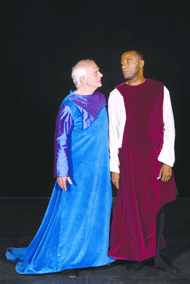Ionesco, Cocteau and company are just the absurdity for a world gone mad
Everything old is new again. Welcome to 1955, when a young woman named Julie Bovasso, an inspired 22-year-old from Brooklyn, is introducing Jean Genet, Eugene Ionesco and Michel de Ghelderode to the United States of America, and vice versa, at the tiny Tempo Playhouse she’s built with her own hands at 4 St. Mark’s Place.
Jump cut to 2005 and the Bank Street Theatre, on the banks of the ancient and honorable Hudson River, where a woman named Shela Xoregos has put together and is directing a quintuple bill of short Surrealist plays by Jean Cocteau, Eugene Ionesco, Michel de Ghelderode, Tristan Tzara and Rene Magritte. Yes, the painter—that Magritte.
Well, loosely speaking Surrealist plays. And gloomy de Ghelderode isn’t really a Surrealist at all.
“He’s in there as a serious anchor,” Xoregos said.
De Ghelderode’s piece, “Escurial,” first staged here 50 years ago by Bovasso, gives us a mad, haunted, death-driven king who plays murderous games with Folial, his court jester. As I said, a bucket of laughs—but a landmark in modern drama.
Fairly familiar to Off-Broadway theatergoers is Ionesco’s “Maid to Marry,” an extended exchange of rampant banalities between a Gentleman and Lady, or husband and wife.
GENTLEMAN: All French postmen are Corsican. Who’d bring in our mail if there weren’t any postmen?
LADY: They’re a necessary evil.
GENTLEMAN: Evil is never necessary.
LADY: How right you are, that’s very true!
The Cocteau is a strangely straightforward but troubling short story, “A Practical Joke,” originally written as a radio play for Jean Marais, the sad, gorgeous, enchanted beast of “Beauty and the Beast” and Cocteau’s bedroom (also of that other Cocteau masterpiece, “Orpheus”).
Tristan Tzara was, strictly speaking, a Dadaist (as in Tom Stoppard’s ingenious “Travesties”), but Tzara was also a bit of everything else. His “The Gas Heart,” in which the characters are Eye, Mouth, Nose, Ear, Neck and Eyebrow, has enough shape and structure (of a sort) to qualify as Surrealist.
And the Magritte? It’s called “The Round Square,” and all three acts fit onto three-quarters of one typed page.
It was David Willinger of City College, a specialist in Belgian Surrealist drama, who told Shela Xoregas about that epic, which, she said, “set everything switching around in my mind until I said what can I do [in one evening] to show different styles of theater in 30 early years [1920s to 1950s] of the 20th century.”
The combine is called “On the Banks of the Surreal.”
Xoregas is especially proud of the two actors who do the Ghelderode—Peter Johnson as the King, Rodney Sheley as the Fool—and of the sculptured Constructivist costumes designed by Russia’s Galina Kuzmetsova for the Eye, Mouth, Nose, etc., of Tzara’s “The Gas Heart.”
To put together this five-part bill, Xoregos “read plays weeks on end.” What she didn’t know when she started out was that two of her chosen Parisian playwrights, Tzara and Ionesco, were originally from Romania, and two others, Magritte and de Ghelderode, were originally Belgian.
“The only Frenchman was Cocteau. And then I learned that Tzara’s real name was Samuel Rosenstock. He was Jewish, and Ionesco was half-Jewish, and Magritte was half-Jewish.”
How about yourself, Ms. Xoregos?
“I’m all Jewish.”
The name Xoregos, pronounced Ko-RAY-goes, is, she said, Greek for “leader of the chorus.”
And your real name?
“That is shrouded in mystery. But it wasn’t Smith.”
The daughter of a cook and a housekeeper, she was born and bred in Pascagoula, Mississippi, near Biloxi. How many Jews are there in Pascagoula?
“More than you think.”
She’s been dancing, choreographing and directing all over the place ever since emerging from Los Angeles City College. One major accomplishment has been a production of Strindberg’s “Miss Julie” set to banjo music in the “post-bustle” American South of 1895, with a black Jean the valet whom Julie lusts for and despises.
The actors at Bank Street are Jen Arvay, Niae Knight, Rachel Lu, Christopher Berryman, Ian Christiansen, John Rose, Dirk Weiler, Peter Johnson and Rodney Sheley. Their director lives alone in Clinton.
“I take in cats once in a while.”
Tristan Tzara says that’s okay.
gaycitynews.com


































